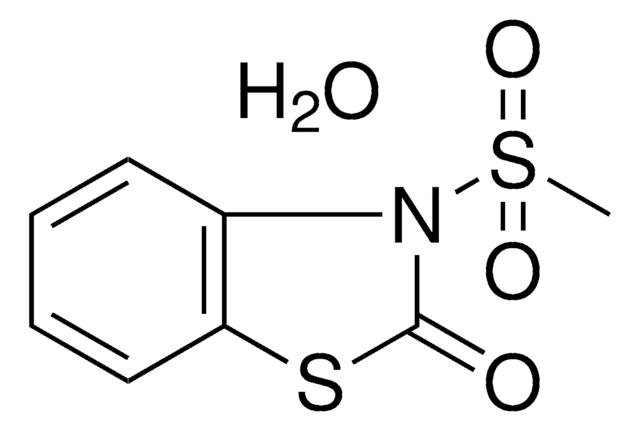NS1226
Cysteine Sulfenic Acid Probe (DCP-Bio1)
About This Item
Produits recommandés
Niveau de qualité
Description générale
The most commonly used method for assessing whether proteins are modified to contain cysteine sulfenic acid employs derivitization with 5,5-dimethyl-1,3-cyclohexanedione (dimedone), and subsequent detection with an antibody against dimedone-modified proteins. However, new reagents have been developed to simplify the analysis and isolation of proteins bearing cysteine sulfenic acid. DCP-Bio1, which consists of the sulfenic acid-reactive 3-(2,4-dioxocyclohexyl) propyl (DCP) appended to biotin, is a useful reagent for characterizing cellular cysteine sulfenic acid.
Application
Solutions:
DCP-Bio1 stock solution
Resuspend entire contents of vial in 10 µL DMSO for a final concentration of 250 mM
Stock lysis buffer
50 mM Tris-HCl, pH 7.5
100 mM Sodium Chloride
0.1% SDS
0.5% Sodium Deoxycholate
0.5% NP-40
0.5% Triton X-100
Working lysis buffer
On the day of the assay, supplement stock lysis buffer with:
50 mM Sodium Fluoride
1 mM PMSF
1 mM DCP-Bio1
100 µM DTPA (Diethylene triamine pentaacetic acid)
10 mM N-ethylmaleimide
10 mM iodoacetamide
200 U/mL catalase
1x protease inhibitor cocktail
Cell treatment and lysis:
1)Seed adherent cells in 100 mm cell culture dishes, or other plate as desired.
2)Change to fresh growth media 30 minutes before selected treatments.
3)Wash all plates 2 times with 10 mL 1x PBS.
4)Add 150 µL working lysis buffer to plates and scrape cells.
5)Incubate lysates on ice for 1-2 hours.
6)Centrifuge lysates at 10,000 rpm for 10 minutes and collect supernatant.
7)Remove un-reacted DCP-Bio1 and other small molecules using Bio-Rad P6-Spin Columns (PN: 732-6227) following manufacturer′s instructions.
8)Measure protein concentration.
9)Perform biochemical analysis of interest.
DCP-Bio1 stock solution
Resuspend entire contents of vial in 10 µL DMSO for a final concentration of 250 mM
Stock lysis buffer
50 mM Tris-HCl, pH 7.5
100 mM Sodium Chloride
0.1% SDS
0.5% Sodium Deoxycholate
0.5% NP-40
0.5% Triton X-100
Working lysis buffer
On the day of the assay, supplement stock lysis buffer with:
50 mM Sodium Fluoride
1 mM PMSF
1 mM DCP-Bio1
100 µM DTPA (Diethylene triamine pentaacetic acid)
10 mM N-ethylmaleimide
10 mM iodoacetamide
200 U/mL catalase
1x protease inhibitor cocktail
Cell treatment and lysis:
1)Seed adherent cells in 100 mm cell culture dishes, or other plate as desired.
2)Change to fresh growth media 30 minutes before selected treatments.
3)Wash all plates 2 times with 10 mL 1x PBS.
4)Add 150 µL working lysis buffer to plates and scrape cells.
5)Incubate lysates on ice for 1-2 hours.
6)Centrifuge lysates at 10,000 rpm for 10 minutes and collect supernatant.
7)Remove un-reacted DCP-Bio1 and other small molecules using Bio-Rad P6-Spin Columns (PN: 732-6227) following manufacturer′s instructions.
8)Measure protein concentration.
9)Perform biochemical analysis of interest.
Composants
Qualité
Stockage et stabilité
Clause de non-responsabilité
Code de la classe de stockage
11 - Combustible Solids
Classe de danger pour l'eau (WGK)
WGK 3
Point d'éclair (°F)
Not applicable
Point d'éclair (°C)
Not applicable
Certificats d'analyse (COA)
Recherchez un Certificats d'analyse (COA) en saisissant le numéro de lot du produit. Les numéros de lot figurent sur l'étiquette du produit après les mots "Lot" ou "Batch".
Déjà en possession de ce produit ?
Retrouvez la documentation relative aux produits que vous avez récemment achetés dans la Bibliothèque de documents.
Notre équipe de scientifiques dispose d'une expérience dans tous les secteurs de la recherche, notamment en sciences de la vie, science des matériaux, synthèse chimique, chromatographie, analyse et dans de nombreux autres domaines..
Contacter notre Service technique





